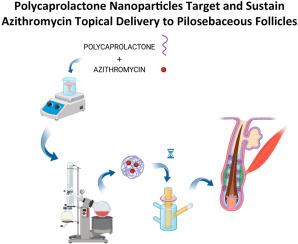Polycaprolactone nanoparticles for targeted and prolonged topical delivery of azithromycin to pilosebaceous follicles
IF 4.9
3区 医学
Q1 PHARMACOLOGY & PHARMACY
Journal of Drug Delivery Science and Technology
Pub Date : 2025-09-20
DOI:10.1016/j.jddst.2025.107559
引用次数: 0
Abstract
Topical administration of antibiotics for localized skin infections offers advantages over systemic therapies, including reduced side effects and minimized antimicrobial resistance. However, when using azithromycin topically to treat acne, the low capacity of this potent antibiotic to reach the affected pilosebaceous units compromises therapy. This study aimed to develop azithromycin-loaded polymeric nanoparticles to enhance follicular targeting and improve topical drug delivery. Thermal analyses showed compatibility and miscibility between azithromycin and polycaprolactone. The polymeric nanoparticles produced by the nanoprecipitation method were spherical, monodisperse (158.3 ± 0.4 nm; PdI<0.1), achieved an entrapment efficiency of 92.5 ± 0.1 % for azithromycin, and exhibited a sustained drug release profile over 12 h. They enhanced drug deposition in pilosebaceous follicles compared to the control drug solution over 24 h. Indeed, 43 ± 6 % of the drug was localized in follicles after 24 h of skin treatment–a fivefold (p < 0.05) increase in the targeting factor relative to control. The nanodispersion was also demonstrated to be non-irritant. In conclusion, the polycaprolactone nanoparticles effectively targeted and prolonged azithromycin delivery to hair follicles while minimizing systemic exposure, offering a promising strategy for the topical treatment of follicle-associated infections.

聚己内酯纳米颗粒靶向和延长局部递送阿奇霉素到毛囊皮脂腺
局部使用抗生素治疗局部皮肤感染比全身治疗更有优势,包括减少副作用和最小化抗菌素耐药性。然而,当使用阿奇霉素局部治疗痤疮时,这种强效抗生素到达受影响的毛囊皮脂腺单位的低能力损害了治疗。本研究旨在开发阿奇霉素负载聚合物纳米颗粒,以增强卵泡靶向性和改善局部药物递送。热分析表明阿奇霉素与聚己内酯具有相容性和混溶性。纳米沉淀法制备的聚合物纳米颗粒呈球形,单分散(158.3±0.4 nm;PdI<0.1),阿奇霉素的包封效率为92.5±0.1%,并且在12小时内表现出持续的药物释放特征。与对照药物溶液相比,它们在24小时内增强了毛囊皮脂腺中药物的沉积。事实上,在皮肤处理24小时后,43±6%的药物定位于毛囊中-相对于对照,靶向因子增加了五倍(p < 0.05)。纳米分散体也被证明是无刺激性的。总之,聚己内酯纳米颗粒有效地靶向和延长了阿奇霉素给药到毛囊的时间,同时最大限度地减少了全身暴露,为局部治疗毛囊相关感染提供了一个有希望的策略。
本文章由计算机程序翻译,如有差异,请以英文原文为准。
求助全文
约1分钟内获得全文
求助全文
来源期刊
CiteScore
8.00
自引率
8.00%
发文量
879
审稿时长
94 days
期刊介绍:
The Journal of Drug Delivery Science and Technology is an international journal devoted to drug delivery and pharmaceutical technology. The journal covers all innovative aspects of all pharmaceutical dosage forms and the most advanced research on controlled release, bioavailability and drug absorption, nanomedicines, gene delivery, tissue engineering, etc. Hot topics, related to manufacturing processes and quality control, are also welcomed.

 求助内容:
求助内容: 应助结果提醒方式:
应助结果提醒方式:


